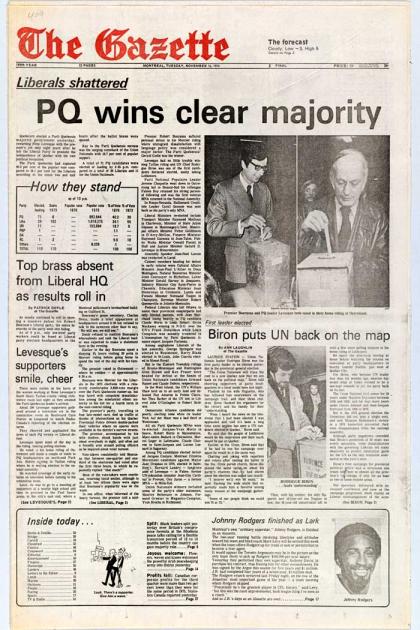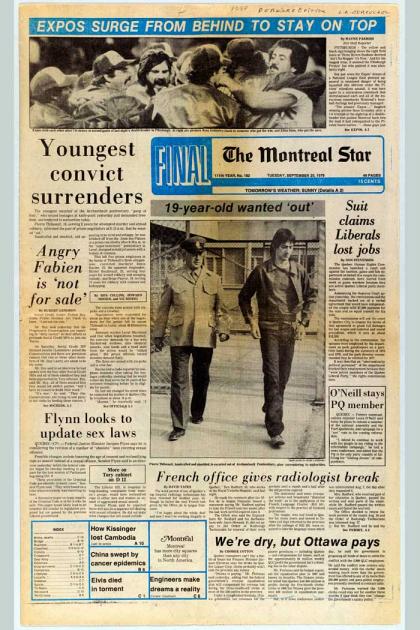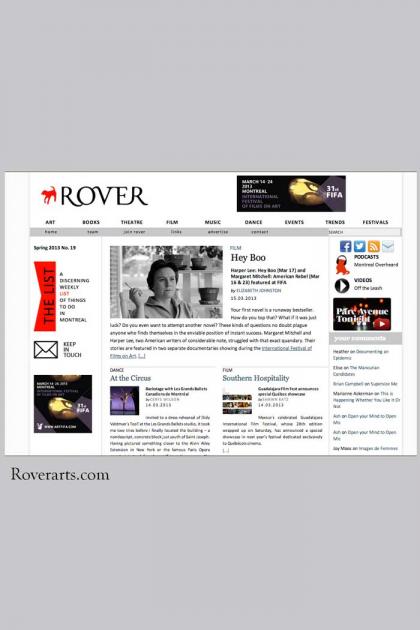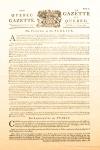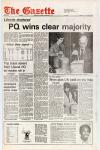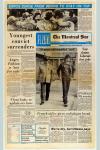Quebec Chronicle-Telegraph, Montreal Star, Montreal Gazette, Rover
Organization: Quebec Chronicle-Telegraph, Bibliothèque et Archives nationales du Québec (BAnQ), Roverarts
Coordinates: www.qtonline.com, http://www.banq.qc.ca, http://www.montrealgazette.com, http://roverarts.com
Address: Quebec Chronicle-Telegraph, 1040 Belvédère, S. 218, Quebec City, QC G1S 3G3; Bibliothèque et Archives nationales du Québec, 475 de Maisonneuve Est Blvd, Montréal, QC H2L 5C4
Region: Montreal, Quebec City Region
Contact: Shirley Nadeau, Shirley(a)qctonline.com (Chronicle-Telegraph); BAnQ, 514-873-1100 or 1-800-363-9028 (Montreal Gazette, Montreal Star), Marianne Ackerman, publisher, marianne(a)roverarts.com (Rover)
Description: First page of four different Quebec newspapers: (1) 1989 reprint of the first issue of the Quebec Gazette on June 21, 1764, forerunner of the Quebec Chronicle-Telegraph; (2) November 16, 1976, issue of the Montreal Gazette, announcing the election of the Parti Québécois; (3) the last publication of the Montreal Star on September 25, 1979; (4) Screenshot of Rover, Spring 2013, No. 19.
Year made: 1989, 1976, 1979, 2013
Made by: unknown
Materials/Medium: paper, ink, internet site
Colours: black and white; full colour
Provenance: Montreal, Quebec City
Size: various sizes
Photos: Rachel Garber (Quebec Gazette); Courtesy Bibleothèque et Archives nationales du Québec and Montreal Gazette (Montreal Gazette, Montreal Star); Courtesy Roverarts (Rover)
Quebec Newspapers
Marianne Ackerman, with files from Shirley Nadeau, Quebec Chronicle Telegraph
Newspapers have been part of Anglo-Quebecois life since the early days. In 1764, William Brown and Thomas Gilmore launched the bilingual Quebec Gazette on a printing press they had brought to Quebec City from Philadelphia, shortly after the Conquest.
Today, the weekly Quebec Chronicle-Telegraph (print and on-line) is North America’s oldest continuously operating newspaper, with only two brief interruptions. One was in 1765, when a stiff British tax on print forced temporary suspension, and the other was during the Siege of Quebec by the Americans in the winter of 1775-1776, when the publisher Brown and his men joined the city’s defence, armed with flintlock muskets.
But while revolt in the thirteen colonies prompted a news blackout in Quebec City, it gave birth to a newspaper in Montreal. Eager to secure the rebels’ grip on the walled city, Benjamin Franklin convinced his friend Fleury Mesplet, a French-born printer, to haul his press across Lake Champlain, so that locally printed news of the rebellion could inspire French-Canadians to declare themselves the 14th Colony. By the time Mesplet arrived in the spring of 1775, the rebels’ occupation of Montreal had crumbled. Franklin fled, leaving the printer stranded and broke. He was promptly arrested as an alien and thrown in jail.
By 1778, Mesplet rallied to launch the first French-language newspaper in Quebec, La Gazette du commerce et littéraire, but it was soon crushed by church censorship after publishing of a laudatory obituary of Voltaire. Undeterred by a second jail stint, Mesplet started over with the bilingual Montreal Gazette/La Gazette de Montréal in 1785, which continued until 1822, when it was purchased by an Anglophone businessman and began publishing exclusively in English.
By the late 1800s, Montreal’s thriving English-speaking community was well served by print media, including the Herald (1811) and the Montreal Star, founded in 1869 by Hugh Graham, First Baron Atholstan. He also ran an illustrated weekly, The Standard, where short story writer Mavis Gallant famously worked before her definitive move to Paris in 1950. The Gazette was in between, a morning paper, considered the voice of Anglo business.
In Quebec City, also a lively news town, mergers in 1874, 1925 and 1934 led to creation of the Quebec Chronicle-Telegraph. Outbreak of war in 1914 forced postponement of the paper’s 150th anniversary celebrations, but the event was held in 1923, a collaboration with The Morning-Telegraph, marking its 75th anniversary. In 1939, a 175th souvenir issue proclaimed The Chronicle-Telegraph “The Empire’s Oldest Surviving Newspaper Enterprise.”
By the time sugar baron John Wilson McConnell purchased the Montreal Star in 1925, it dominated the city’s lucrative evening newspaper business. By the 1940s, The Star had a circulation of some 180,000 and stayed on top for three decades. In 1951, the splashy Weekend Magazine was launched with a national press run of 900,000.
November 15, 1976, was a game-changing date for Quebec Anglophones - the first election of the Parti-Québécois. But three years later, September 25, 1979, seemed almost as important - the day the Montreal Star ceased publication.
A strike by the printers’ union had kept the Star from publishing for eight long months, handing circulation and ad revenue to The Gazette. But the beloved beast seemed to snap back. Its sudden death six months later came as a shock to Anglo-Montrealers who considered the Star’s flashy news reporting style and beloved columnists part of their daily existence.
Many Star writers found work at The Gazette. As a monopoly, flush with revenue, it bought the Star’s press and archives, moved into the Star building and settled contracts, giving Gazette employees salaries second only to the New York Times.
These were changes readers could see and feel, but the real harbingers happened behind the scenes, as community-oriented, family-owned newspapers across North America began sliding toward hard times, beginning with a series of corporate mergers, then coming face to face the tsunami of a powerful new medium, the world wide web.
The Gazette was acquired by FP Publications in 1973, owner of the Globe and Mail, then by Southam Inc. in 1968, by Conrad Black’s Hollinger Inc. in 1996, by the Winnipeg-based Canwest in 2000, and finally in 2012 by Toronto-based Postmedia News. Each acquisition called for belt tightening for the purposes of increased shareholder profits. Today, the Montreal operation is profitable, although the chain as a whole is not.
The Gazette newsroom staff hovers around 100, compared with 300 at its peak. Many editors do jobs previously held by three or even four people.
Increasingly, the newspaper’s hope for survival is pinned on the on-line version, which as yet has no local competition. The American web chain Huffington Post Quebec is doing well (in French), as are sites in Toronto (called Canada), Vancouver and Atlantic Canada, but “HuffPo” has no plans for an English-language Quebec version. The web may be the future of what it was newspapers were created to do, but how to make a free-for-all medium into a paying one is still an open question.
In 2008, I returned to Montreal after seven years in the South of France, where I read no newspapers at all. Shocked by the decline of arts coverage here and dazzled by the potential of on-line technology, I founded the Rover, a web magazine offering daily posts about the cultural life of Montreal - a sideline to my main work as a playwright and novelist.
Five years and some 1800 original posts later, Rover has earned a solid readership and something like institutional status in the Anglo arts scene. But without grants or much advertising, www.roverarts.com remains a cause - albeit an important part of my sense of connectedness in these devolutionary times. Same pretty much goes for our “competition” – www.forgetthebox.net, a cheeky, more political site, and www.cultmontreal.com, launched by staff from The Mirror, an entertainment weekly that folded, as did its rival, Hour, last year.
As this brief history shows, Quebec’s legendary newspapers were created by individuals who possessed both a means of production and a hungry public. Somehow, I doubt much has changed. Hunger, though, is essential. The public must play an active role. A community gets the media it wants and deserves.
Sources
On Mesplet and censorship: http://www.societehistoriquedemontreal.org/wp-content/uploads/2011/07/hi...
Huffington Post Quebec, http://www.huffingtonpost.ca/patrick-white/huffpost-quebec_b_2640414.html
Files from Shirley Nadeau, Quebec Chronicle Telegraph: Shirley(a)qtonline.com
To Learn More
W.H. Kesterton, A History of Journalism in Canada, 1967.
Quebec Chronicle Telegraph www.qctonline.com/history
The Quebec Mercury www.collectionscanada.gc.ca
George Fetherling and Douglas Fetherling, The Rise of the Canadian Newspaper, 1990.
Authors
In the 1990s, Marianne Ackerman was artistic director of THEATRE 1774, where her bilingual play L’Affaire Tartuffe, or the Garrison Officers Rehearse Molière, was produced. She has published three novels, including the best-selling Jump, set during the 1995 Referendum. Shirley Nadeau is the Copy Editor and a contributor to the Quebec Chronicle-Telegraph.



